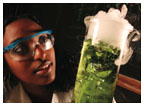
|
|
November 16, 2005: President's Page
THE ALUMNI WEEKLY PROVIDES THESE PAGES TO THE PRESIDENT
Helmae Wubneh ’08 at work in Frick Laboratory. Here she dissolves dry ice in an indicator solution. |
Chemistry in the 21st Century
There are moments in the life of every academic department when new ideas and new opportunities come together—often fortuitously—to revitalize its mission. This was true of molecular biology in the 1980s, and today it is true of chemistry. Last spring, a multidisciplinary faculty committee chaired by Dean of the Graduate School William Russel considered the most promising future research areas in chemistry and outlined a strategy that would place the Department of Chemistry at Princeton in the leadership ranks of the field.
At the heart of this strategy lies the realization that chemistry is a discipline whose intellectual spokes extend to virtually every other scientific sphere, that it is an increasingly indispensable partner for the physical and biological sciences, as well as engineering, and that its rich tradition of invention and interpretation is an essential element of any scientific education. More than 75 years ago, when the Department of Chemistry’s current home, Frick Laboratory, was dedicated, the eminent chemist Hugh Stott Taylor declared that “there are now abundant evidences that in the new fields to be conquered chemistry must draw yet more largely from her sister sciences of physics and mathematics.” While chemistry continues to rely on physics and mathematics, the opposite is true as well—many disciplines now draw on chemistry in order to make significant progress.
From the development of new intermetallic superconductors to the explanation of how bacteria communicate when acting collectively, chemists are advancing both their own field and contributing to many others. One of the things that excites me most as a molecular biologist is the potential of chemistry to help us understand how even the smallest molecules function in biological systems of infinite complexity. For example, chemists are producing molecules with “tags” that allow us to follow their movements in biological systems. Miraculously, these “tags” are designed in a way that does not affect the molecules’ behavior. Armed with this fundamental knowledge, chemists and biologists can now develop molecules that interfere with specific biological processes—thereby slowing or halting disease.
Progress in 21st-century chemistry and the partnerships that the field is forging with other disciplines depends on a facility that will encourage interaction and collaboration. Frick Laboratory, which stands far closer to the homes of history and English in Dickinson and McCosh halls than to those of physics and biology, is not conducive to either activity. It was built at a time when science was conducted differently; when faculty and their protégés frequently formed isolated groups rather than open societies. Furthermore, the strenuous demands of modern technology on the infrastructure of a building have exhausted the capacity of Frick Laboratory to adapt to change. For many years—and especially during the chairmanship of Professor George McLendon—the Department of Chemistry has pressed for new quarters, but the cost of constructing a building that could house the entire department and meet the rigorous technical requirements was prohibitive. Then—and this is what I mean by new opportunities—the work of Edward Taylor, the A. Barton Hepburn Professor of Organic Chemistry, Emeritus, bore extraordinary fruit in the form of Alimta, a therapeutic drug that he developed in cooperation with the pharmaceutical company Eli Lilly. Princeton holds the U.S. patent to this drug, which has been effective in combating mesothelioma, a deadly cancer linked to exposure to asbestos. The royalties from Alimta, which was approved by the U.S. Food and Drug Administration last year, will give us the means to construct a state-of-the-art chemistry building that will encourage the kind of pioneering research with which Professor Taylor is synonymous. It is deeply gratifying to know that the future success of our Department of Chemistry has been secured through the ingenuity of a greatly admired member of our faculty.
Sir Michael Hopkins of the British architectural firm Hopkins Architects has been selected to design our new chemistry building in collaboration with Payette Associates, a Bostonbased firm of architects that has helped plan other laboratories on our campus. Situated on what is now the site of the Armory, the building will be both beautiful, taking full advantage of its wooded setting, and functional, integrating offices, classrooms, and laboratories in creative ways while meeting their discrete requirements. Its nearest neighbor will be Jadwin Hall, which houses the Department of Physics, but a striking pedestrian bridge will link it to the life sciences on the other side of Washington Road.
While a new building may be necessary, it is not itself sufficient to
move chemistry in fresh directions. It will, however, attract the scholars
and students who can do so. Here, too, we have an opportunity that is
rarely open to academic departments that wish to refocus their energies
without significantly increasing the size of their faculty. Departures
and retirements are thinning the Department of Chemistry’s ranks,
notably in chemical biology and physical chemistry, and as many as a dozen
vacancies will have to be filled in the next decade. We have developed
a two-pronged strategy for bolstering the faculty, one that will initially
focus on attracting a few distinguished scientists who will have an immediate
“transformational” effect on the department and its international
visibility. They will then join their colleagues in recruiting a critical
mass of junior faculty. Chair of Chemistry Bob Cava believes—and
I think rightly—that the strongest departments are those that attract
a cohort of young scholars, men and women with unexpected insights who
are hungry to challenge the assumptions and limitations of those who came
before. That is where we will find the next Ted Taylor. ![]()


